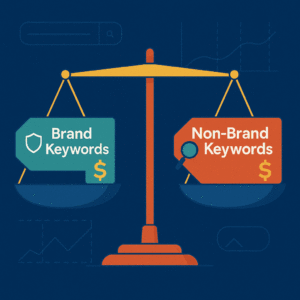Finding the Right Keyword Mix: How Franchise Home Service Brands Should Balance Brand and Non-Brand Paid Search Campaigns
Introduction
When it comes to paid search campaigns, one of the most important (and often misunderstood) questions is this:
How much of your budget should go toward your brand name keywords vs. broader, non-brand terms?
A recent performance analysis across multiple franchise locations of a leading home service brand sheds light on the answer. The data makes it clear that both keyword types serve important — but very different — roles. And the most effective strategy is one that balances both.

Understanding the Two Keyword Types
- Brand keywords (e.g., “[Brand Name] roof repair”)
→ Target customers who already know your business. These campaigns are defensive in nature, helping protect your brand against competitors and secure high-intent traffic at low cost. - Non-brand keywords (e.g., “roof repair near me”, “roof construction”)
→ Target new, unaware customers. These campaigns focus on demand generation and are crucial for growing market share and acquiring new customers.
Metric | Brand Keywords | Non-Brand Keywords |
Avg. Leads per Location | 4.7 | 117.5 |
Avg. Booked Jobs per Location | 5.9 | 122.4 |
% of Total Spend | 2.08% | 97.92% |
% of Total Leads | 3.85% | 96.15% |
% of Total Booked Jobs | 4.60% | 95.40% |
Brand campaigns cost 60% less per lead while protecting bottom-of-funnel traffic.
Why You Should Always Separate Brand & Non-Brand Campaigns
One of the most critical steps in campaign structure is keeping brand and non-brand keywords in separate campaigns — and ideally in separate budgets.
Here’s why that matters:
Accurate Performance Tracking
Brand campaigns artificially lower your average CPL. Because users searching for your brand are already familiar and more likely to convert, their cost per lead is significantly lower. Mixing brand and non-brand terms together skews your true performance metrics, especially when evaluating ad copy, landing page performance, or keyword intent.
Different Value, Different Intent
Brand leads typically don’t represent new customer acquisition. They often come from returning customers, referrals, or people already influenced by your brand. That’s valuable — but very different from someone who finds you for the first time through a generic search. Non-brand campaigns tend to bring higher lifetime value customers, even if they come at a higher cost.
Better Budget Control
Separating campaigns lets you allocate budget intentionally. You might only want to spend 5% on brand keywords — just enough to maintain top visibility and defend against competitors — while investing the rest in acquisition-focused terms.
Clearer Attribution
If you’re reporting ROI or running lead attribution through a CRM, separating campaigns gives you clarity on which efforts are driving new business vs. defending existing demand.
Pro Tip: Use campaign naming conventions like “Brand – [Location]” and “NonBrand – [Location]” to keep reporting clean and scalable across multiple markets.
Strategic Recommendations
- Always Maintain a Brand Keyword Campaign
Even if your organic listing ranks #1, competitors can still outrank you with paid ads. Brand campaigns defend your name and close the loop with high-intent customers. - Invest Aggressively in Non-Brand for Growth
Use broader terms to capture new customers and grow awareness in your territory. Monitor CPLs and pause underperforming ad groups as needed. - Monitor Your CPL Split
Aim for an overall CPL that balances the efficiency of brand with the reach of non-brand. If your non-brand CPL becomes unsustainable, reallocate budget or refine targeting. - Set Benchmarks Based on Intent
Expect a higher CPL from non-brand keywords, but hold them to a different standard. Consider metrics like new customer acquisition rate, impression share, and conversion lag when evaluating success.
Example Keyword Budget Strategy
Here’s a sample budget allocation model to consider:
| Campaign Type | Budget Share | Goal |
| Brand Keywords | 5–10% | Protect brand, convert high-intent users |
| Non-Brand Keywords | 90–95% | Drive new customer acquisition |
Adjust this based on your market competition, CPL trends, and brand strength in your local area.
Final Thoughts
There’s no one-size-fits-all formula for keyword mix — but the data makes one thing clear:
Exclusively focusing on one type leaves opportunity on the table.
Franchisees and home service brands that separate brand and non-brand campaigns, track them independently, and balance efficiency with growth are better positioned to compete and convert in today’s search landscape.
As the franchise business model continues to evolve in 2025, forward-thinking franchisors are embracing not just growth, but responsible growth. In a landscape where ownership changes, digital complexity, and brand consistency challenges loom large—especially for local lead-driven industries like home services and fitness—brands that scale responsibly are those that prioritize long-term alignment between corporate (franchisor) strategy and local (franchisee) execution.
This is where responsible franchising and scalable local advertising converge. And it’s where Adplorer can future-proof franchise operations and empower sustainable growth—no matter how many new owners enter the system over time.


